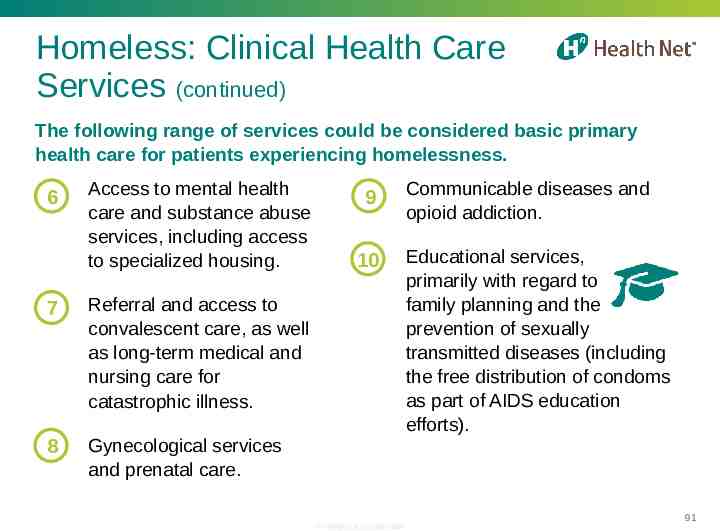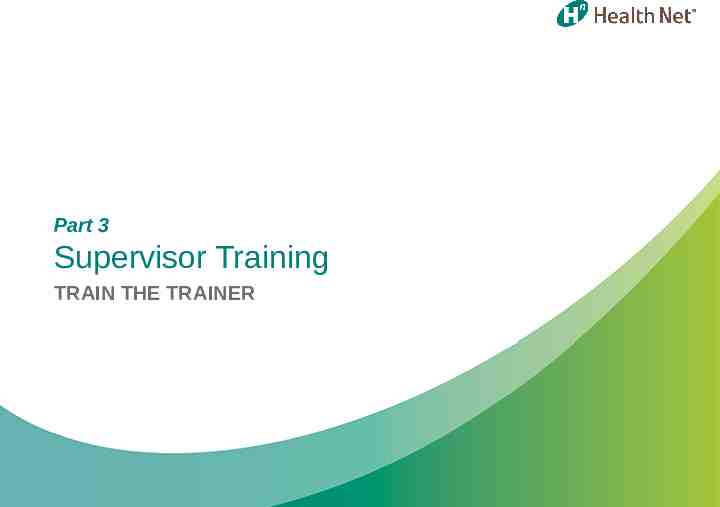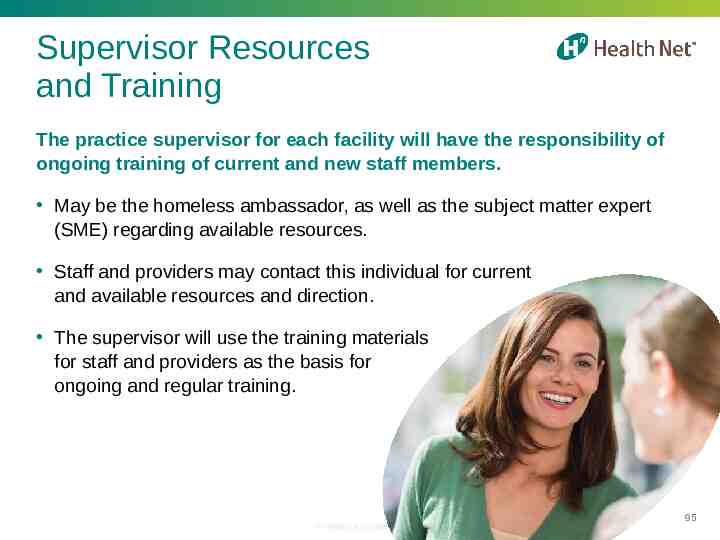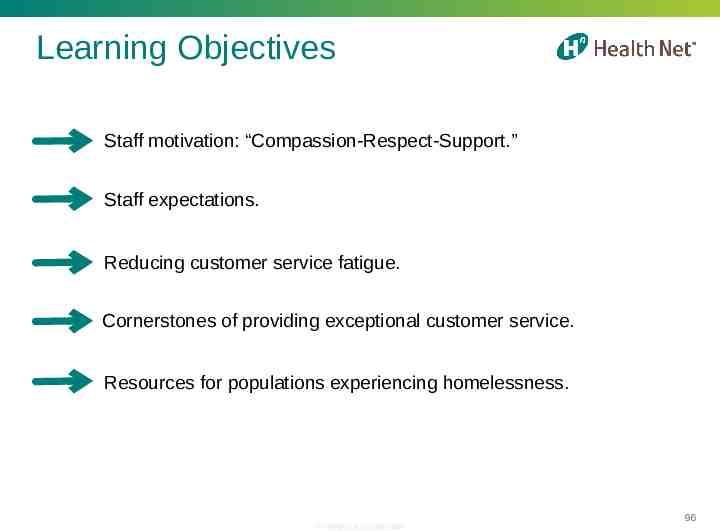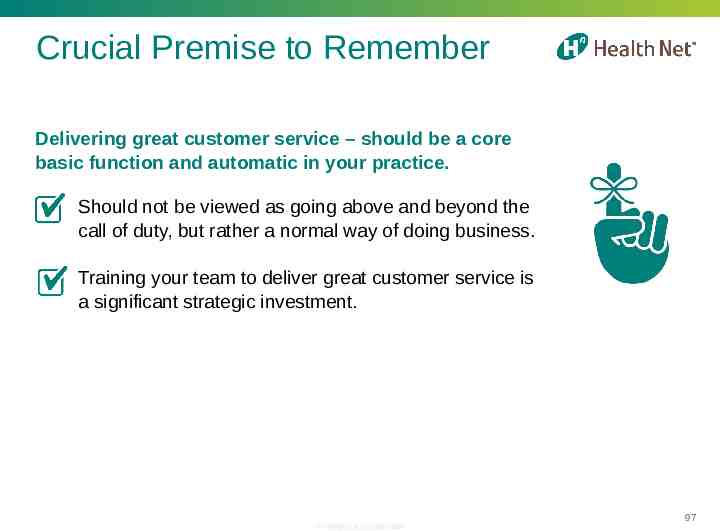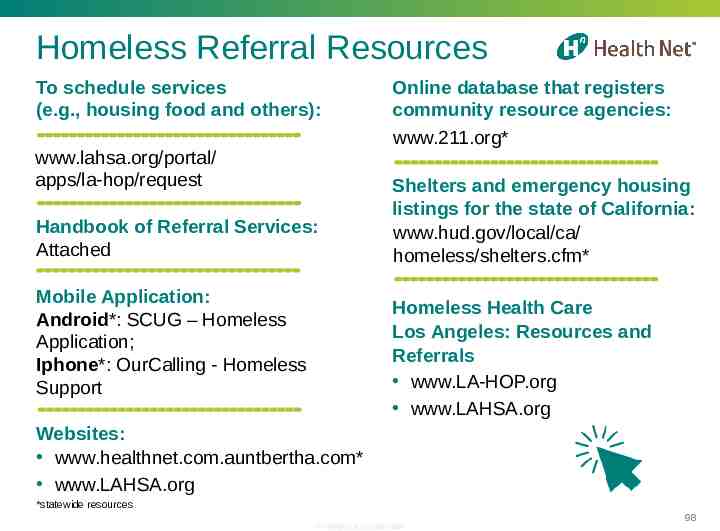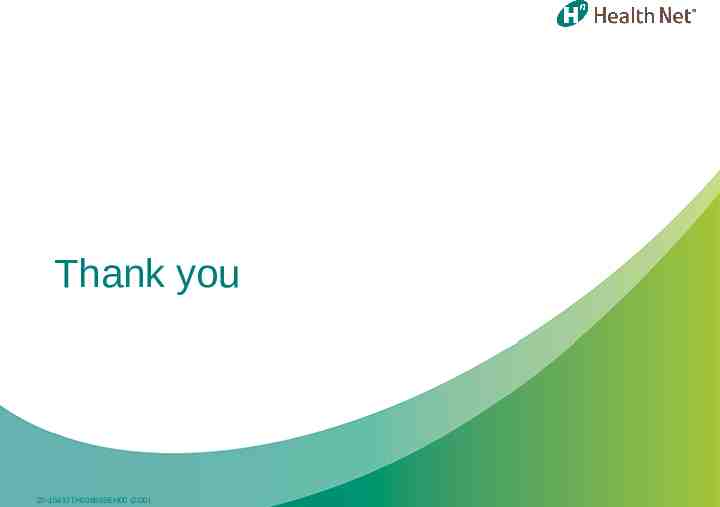Delivering Compassionate Customer Service PATIENTS EXPERIENCING
99 Slides5.04 MB
Delivering Compassionate Customer Service PATIENTS EXPERIENCING HOMELESSNESS Presenter Name Presenter title or other info
Part 1 Building Cultural Sensitivity and Equality for Our Patients/Members Experiencing Homelessness DELIVERING COMPASSIONATE CUSTOMER SERVICE
Background Provide compassionate care to patients experiencing homelessness. Increase provider awareness of the life circumstances, the clinical and emotional conditions, and the other factors affecting our patients/members who are experiencing homelessness. Assist providers with providing compassionate and respectful care. Privileged & Confidential 3
The Components of Customer Service Training
Three Focus Areas Provider – Clinical training Challenges/ obstacles. Patient sensitivity and culture. Patient-centered framework and patient engagement. Organizational communication and climate. Referral resources and tools. Manager – Supervisor training and development Providing information, which enables managers and supervisors to provide ongoing training to staff. Privileged & Confidential Staff training and development Compassionate customer service training, sensitive to the needs of patients experiencing homelessness. Support and resources. 5
Crucial Premise to Remember Great customer service: Should be provided to all patients and is the basic foundation when building a healthy relationship. Should not be viewed as going above and beyond the call of duty, but it is your responsibility and crucial to the success of the practice. Essential to bridge the gap between what separates your patients from being consistent and compliant with their care. Privileged & Confidential 6
Staff Training Session Understanding the conditions faced by individuals experiencing homelessness Individuals who are experiencing homelessness: Who are they & how did this happen? (If video does not load, please click here: https://www.youtube.com/watch?v CqwjaExT4wA) Privileged & Confidential 7
Could This Be Me? Some important data* Four leading causes of homelessness: Lack of affordable housing Poverty Unemployment Low wages *National Law Center On Homelessness and Poverty Report. National Coalition for the Homeless - 2201 P. St. NW, Washington, DC 20037 Privileged & Confidential 8
Could This Be Me? What about us? What would happen if you were out of work for 90 days? Experienced a medical emergency that prohibited you from working? Car broke down and you didn’t have the money for repairs? Family members could not provide support? What would you do? Where would you go? Privileged & Confidential 9
Understanding our Personal Biases Unconscious bias – social stereotypes about certain groups of people that individuals form outside their conscious awareness. Occurs automatically outside of our control and is triggered by quick judgment. Bias is a tendency to lean in a certain direction, often based on your own personal experiences. Detriment of an open mind. Believe what they want to believe. Refuse to take into consideration the opinions of others. Privileged & Confidential 10
Interactive Exercise for Attendees
Overcoming Personal Biases to Deliver Customer Service Three steps you can take to overcome your individual bias: 1 Be aware of who you are. 2 Acknowledge that the homeless condition may impact your behavior. Privileged & Confidential 3 Show compassion and empathy. 12
Delivering Compassionate Customer service
Key Objectives Create a culture that supports and aligns with delivering compassionate customer service. Dedicate resources and training time consistently to employees to enhance their current knowledge by teaching new information to ensure success. Build a positive patient experience as they journey through the practice. Privileged & Confidential 14
Identify Patients Experiencing Homelessness There is no clear-cut way. Patients may be experiencing different levels of homelessness and still appear very well groomed. But some other signals to observe are: Wearing layers of clothing. Unmet medical and dental needs. Poor hygiene. Extreme shyness. Sleeping in public areas. Extreme anger or embarrassment when asked about current address. Worn shoes. Privileged & Confidential 15
Success Factors Privileged & Confidential 16
The Health Care Encounter There are many cultures at work in each health care visit: Culture of Bio-Medicine Culture of Health Care Institution Patient’s Culture Health Care Encounter Interpreter’s Culture Provider’s Culture Privileged & Confidential 17
Delivering Exceptional Customer Service Develop a renewed sense of empathy to our patients experiencing homelessness. Be sensitive to the special needs of patients experiencing homelessness: Be ready to address multiple health concerns; their health has probably been neglected due to their housing insecurity issues. Be aware that housing insecurity can encompass other social determinants of health such as food insecurity; know how to address this. Be a resource by being resourceful; leverage your relationships within your medical neighborhood to foster a reputation of efficiency. Provide an extra sense of security for the patients and their belongings; this may be everything they own. Privileged & Confidential 18
Delivering Exceptional Customer Service (continued) Be in control of: Yourself and your actions (emotions). Patients. Enjoy the service that you render to patients. Recognize how important you are to patients. Recognize that every patient represents an opportunity to deliver extraordinary service. Privileged & Confidential 19
Key Office Processes and Office Design Providing service to patients experiencing homelessness will likely require process redesign. Designate a staff member to serve as an ambassador to this population. This person may: Ensure the patient and their belongings, including their pet if applicable, are secure. Assist the patient during their entire patient care visit. Address and provide as many services as possible (medical/dental) on the day of service in the event the member does not return to your facility. Maybe bring the patient into the exam room early and conduct the patient process in the room rather than at the front desk. Identify key referral resources to optimize patients’ care. Ensure there is a patient follow-up and compliance method; this means future contact information if possible. Privileged & Confidential 20
Compassion HELPING THE PATIENT “FEEL” YOUR COMPASSION
How Do You Treat Patients Experiencing Homelessness? Compassion and respect core principles Greet the patient with respect and dignity. Identify their immediate need(s) for medical care. Identify if this patient has special needs, namely storage of personal belongings so that they feel secure and can focus on their health care. Privileged & Confidential 22
How Do You Treat Patients Experiencing Homelessness? (continued) Compassion and respect core principles Quick Response. Make an effort to immediately call the patient in for triage and services. Exam Room Interview. In the security of the exam room, you should continue to ask the patient routine geo-mapping questions. Be Safe. Due to possible mental health challenges, always use safety precautions. Possibly have two staff members present in the exam room. Privileged & Confidential 23
Geo-Mapping the Patient Compassion and respect core principles Geo-mapping enables the provider office to locate and contact the patient for follow-up care, and to identify any risk associated with the patient’s current living conditions. Sample questions are: What is the best way to contact you? What area of the city can we locate you? Do you have a relative or friend that we can contact in order to reach you? Where do you typically sleep at night? Do you have a cell phone? Privileged & Confidential 24
Levels of Homelessness Compassion and respect core principles There are several social determinants that may define a homeless status. In 2017, the number of people experiencing homelessness living in vehicles increased 143 percent. Privileged & Confidential 25
There are three types of homelessness: The transitionally homeless make up a staggering 80% of the homeless population. People who are episodically homeless account for 10–15% of the homeless population. We estimate the number of long-term, chronically homeless people, who have spent more than a year on the streets, is as little as 5% of the entire homeless population. Privileged & Confidential 26
Delivering Exceptional and Compassionate Customer Service What attitudes should you exhibit in order to assist in providing good service? Enjoy helping people. Handle people well. Care for your customers. Give fair and equal treatment to all. Be understanding of people with special needs. Privileged & Confidential 27
Compassionate Customer Service: “Every Time, Every Patient!” Compassionate culture and atmosphere – Consistently show patients you are concerned about their welfare every time. Body language – Sends a multitude of signals to our patients. Listening skills – Talk less and listen more. Be unbiased – Treat everyone with dignity and respect. Privileged & Confidential 28
The Front Desk Behavior The purpose is to create and maintain a welcoming environment – how can you achieve this? Enjoy helping people. Tell them your name. Be attentive; acknowledge a person as soon as they appear, even if you’re busy. Ask how you can help. Give the customer your full attention; avoid other distractions, such as telephone and coworkers. SMILE! Establish and maintain eye contact. Always be polite and courteous. Privileged & Confidential 29
Perception and Customer Service Encourage teamwork among all staff. Poor front office experience poorly perceived care. % Opinions are formed during the first 7–15 seconds of meeting someone. Over 50% percent of patients judge the doctor’s visit based on what happens before they ever see the physician or other caregiver. Privileged & Confidential A significant component of the patient satisfaction survey reflects how well you take care of the patient at the front desk. 30
My Top 10 BASIC RULES TO DELIVERING AMAZING CUSTOMER SERVICE
Ten Rules: Amazing Customer Service 1 Commit to quality service: Create a positive experience. Know your business: Win the patient’s trust and confidence. 3 Treat patients with courtesy and respect: Every contact leaves an impression. Go above and beyond patient expectations. 2 4 Train staff to use phrases like “Sorry to keep you waiting,” You’re welcome,” and “It’s been a pleasure helping you.” Know your patients: Tailor your services to the patient’s needs. Get to the root of patient dissatisfaction. Privileged & Confidential 32
Ten Rules: Amazing Customer Service 5 Never argue with a patient Be solution-focused rather than problem-focused. 6 Don’t leave the patient hanging: 7 Always provide what you promise: Failure to do this is a quick way to lose credibility. If you can’t provide what you promised, then offer an alternative. All communications with the patient should be treated with urgency. 8 95% of dissatisfied patients give you a second chance if the problem is solved on the spot. Assume that patients are telling the truth: The majority of patients don’t like to complain; in fact they’ll go out of their way to avoid it. Privileged & Confidential 33
Ten Rules: Amazing Customer Service 9 Focus on creating satisfied patients: Give attention to the quality of patient interactions, understanding and addressing patient’s needs. 10 Make it easy for patients to access and receive services: Make sure your processes are patient/user-friendly. Research shows that it costs 6 times more to attract new patients. Privileged & Confidential 34
Quality Verbal and Non-Verbal Communications It’s not what you say, but rather how you present: 55% comes from body language 38% 7% comes from comes from tone of voice words Privileged & Confidential 35
What Does the Patient Desire? Friendliness Empathy Fairness Participation Alternatives Information Privileged & Confidential 36
Taking the H.E.A.T. DEALING WITH DIFFICULT PATIENTS
Understanding How Patients Feel When staff is aware they will be asking patients about their customer service experience, they tend to perform at a higher level. Create tools where every staff member routinely asks the patient about their visit: “Did we take care of your needs today?” “It was great to see you today; did your visit go well?” “Give me a call regarding your next appt. I will be right here to take care of you.” “We really enjoy having you as our patient; is there anything else I can do for you?” Privileged & Confidential 38
Taking the Heat At the front reception desk, we take a lot of H E A T ! Ensure you are equipped to handle every situation that arises. Handle each situation with confidence, empathy and knowledge. Resolve the problem and exceed the patient’s expectations. Privileged & Confidential 39
Taking the Heat HH ear them out E mpathize A pologize T ake responsibility for action Privileged & Confidential 40
Hear: Listen to the Patient H ear what the patient has to say: Allow the patient to express their concerns. Patients have a story they need to tell. Let the patient tell you why they are upset. When appropriate, respond with a solution. “Mr. Johnson, I apologize that you had that experience. I have a solution to your problem. I can have the doctor see you now.” Privileged & Confidential 41
Empathy E mpathize Let patients know that you understand them and that you desire to help them. Examples: “I understand why you are upset/angry; I am here to help you! You have all of my attention.” “I am going to fix this situation right now. And I will make every effort to make sure it does not happen again.” Privileged & Confidential 42
An Apology A pologize Let patients know you are sincerely sorry that you made a mistake (perceived or real). Examples: “I apologize for the situation.” “I apologize that we have you scheduled at a different facility. Would it be okay if I have another physician see you today?” “I apologize for the confusion that you encountered.” “I am so sorry that we did not meet your expectations; I want to correct that!” “Please forgive us for this mistake.” Privileged & Confidential 43
Take Responsibility T ake responsibility for action Solve the problem. Examples: “I can take care of this problem right now.” ”I will need to call my office manager, and he/she will solve this challenge right away.” Privileged & Confidential 44
Patient Needs Meet or exceed the patient’s needs: Clarify the need first, and then take action. Exceed their need. Privileged & Confidential 45
Patient Satisfaction Confirm the patient’s satisfaction with your service: Ask! Privileged & Confidential 46
Test Your Knowledge
Question 1 A new male patient presents at the front desk asking to see a physician. His appearance is questionable (e.g., layered clothing, somewhat unclean, and unkempt facial hair). It is clear that the patient requires medical attention and needs to see a provider. What should you do? Privileged & Confidential 48
Answer Select the appropriate answer A.A Assume the patient is homeless and use a referral list to send them to another location. Notify the supervisor of your actions. B The patient has no insurance and therefore we will not be able to provide care for him. C. C Make every effort to accommodate the patient and process him into the system to see a provider. Make special accommodations for his belongings to ensure they are secure. D. D Immediately refer the patient to the nearest homeless shelter for assistance and health care services. Advise them to go directly to that facility for future care. Privileged & Confidential 49
That’s right! Continue Privileged & Confidential 50
Oops, that’s wrong Try again Continue Privileged & Confidential 51
Question 2 A homeless patient arrives with no scheduled appointment and seems to be in need of health care. She does not have the best hygiene and has several bags of clothing. You can clearly see that she is hesitant and/or uncomfortable when signing in, however she is cognitive and is asking to see a provider. How should you handle this situation? Privileged & Confidential 52
Answer Select the appropriate answer A B Leave the patient in the waiting room and call on her in the order of her arrival to the reception area and obtain as much information as possible. C Contact the ambassador or supervisor. Arrange for the patient to go to a designated patient exam room for services. Notify the provider. D Have the patient sign in and leave their belongings outside to avoid any unwanted odors in the office. Treat them as you would all other patients. Call the local shelter and make arrangements for the patient to receive services. Notify the patient that you have arranged for services at a local shelter and they can wait outside for the shelter representative to arrive. Privileged & Confidential 53
That’s right! Continue Privileged & Confidential 54
Oops, that’s wrong Try again Continue Privileged & Confidential 55
Question 3 A patient arrives at the medical office presenting with a rash and is coughing. He expresses concern that he may have a communicable disease; he seems to be in pain and wants to see a physician. The patient has no insurance and has not listed a location for his permanent address. Privileged & Confidential 56
Answer Select the appropriate answer A Refer the patient to the nearby urgent care facility for health care. B Process the patient as you would other patients in the practice. C Let the patient know that he would be better served at the county clinics that can accommodate his needs. D Contact the patient ambassador to process and provide care for the patient. Privileged & Confidential 57
That’s right! Continue Privileged & Confidential 58
Oops, that’s wrong Try again Continue Privileged & Confidential 59
Question 4 A patient arrives at the front desk and is screaming at the staff, and while you have managed to calm her down she is still very rude to you and your coworkers. Privileged & Confidential 60
Answer: Select the appropriate answer A Immediately remind the patient that such behavior will not be tolerated and ask the patient to leave the practice immediately. C Calmly begin to communicate with the patient and determine their concerns. Contact the supervisor to make him/her aware of the situation. B Ask the patient to take a seat and contact the supervisor to handle this patient’s irate behavior. D Remind the patient you are there to take care of their needs, but they must improve their behavior before you will provide service. Privileged & Confidential 61
That’s right! Continue Privileged & Confidential 62
Oops, that’s wrong Try again Continue Privileged & Confidential 63
Behavior Change: TTD Model of Behavior Change (Understanding the process of change in patients experiencing homelessness) There are 5 critical stages toward changing patient behavior. Stage 1: Pre-contemplation (not ready to change). Stage 2: Contemplation (getting ready). Stage 3: Preparation (ready to change). Stage 4: Action. Stage 5: Maintenance. Privileged & Confidential 64
Homeless Referral Resources To schedule services (e.g., housing food and others): www.lahsa.org/portal/ apps/la-hop/request Handbook of Referral Services: Attached Mobile Application: Android*: SCUG – Homeless Application; Iphone*: OurCalling - Homeless Support Online database that registers community resource agencies: www.211.org* Shelters and emergency housing listings for the state of California: www.hud.gov/local/ca/ homeless/shelters.cfm* Homeless Health Care Los Angeles: Resources and Referrals www.LA-HOP.org www.LAHSA.org Websites: www.healthnet.com.auntbertha.com* www.LAHSA.org *statewide resources Privileged & Confidential 65
Part 2 “An Integrated Health Care Model for Patients Experiencing Homelessness” CLINICAL PROVIDER TRAINING COMPONENT
Learning Objectives Understanding the patient care model for populations experiencing homelessness. Assessing the challenges of delivering health care to populations experiencing homelessness. Providing cultural sensitivity for patients experiencing homelessness. Understanding the clinical issues impacting patients experiencing homelessness. Understanding how to provide customer service compassionately. Identifying current patient resources to assist population needs. Privileged & Confidential 67
Focus Areas Delivery of patient-centered care to patients experiencing homelessness. Define behavioral health. Define the common behavioral health conditions among populations experiencing homelessness and offer tips for what you can do to help. Define and understand dual diagnosis. Take note of cultural factors that can impact our assessment. Recommendation for effective patient engagement. Privileged & Confidential 68
Homeless: Who Are They and How Did This Happen (If video does not load, please click here: https://www.youtube.com/watch?v CqwjaExT4wA) Privileged & Confidential 69
What Causes People to Experience Homelessness? Discuss the training conducted with the staff (This could be Me) Some important data* Lack of affordable housing. Poverty. Unemployment. Low wages. *National Law Center On Homelessness and Poverty Report. National Coalition for the Homeless - 2201 P. St. NW, Washington, DC 20037 Privileged & Confidential 70
What about Us? What would happen if you were out of work for 90 days? You experienced a medical emergency that prohibited you from working? Your car broke down and you did not have the money for repairs? Family members did not or could not provide support? What would You do? Where would You go? Privileged & Confidential 71
A Clinical Perspective to Treating Patients Experiencing Homelessness Some lessons learned from a clinician in the community who has spent considerable time caring for patients experiencing homelessness. Meet patients where they are Patient may not feel comfortable coming to the office. Some offices have the resources to go directly to the patient. Perceived barriers – They may see themselves as outsiders and feel as though they are not welcome. Real barriers – Try to make provisions for the following challenges: Transportation. Personal hygiene (cannot shower prior to visit). Cannot bring pets. Cannot bring belongings. Privileged & Confidential 72
A Clinical Perspective to Treating Patients Experiencing Homelessness (continued) Contact Vaccines for Children (VFC) for outreach teams that provide services: – Link homeless patient to services. – Outreach teams are subsidized by Proposition H funding. Street outreach addresses disparities in health care. University of Southern California (USC) and VFC are training providers on street medicine. Engaging the population is important; gaining trust can take 1 minute to 16 months, depending on patient. Address each condition for the tri-morbid population. Medication-assisted therapy (MAT), suboxone-opioid replacement treatment. Privileged & Confidential 73
A Clinical Perspective to Treating Patients Experiencing Homelessness (continued) Being versed in different types of addictionology, addiction services in addition to good medical care. Good intervention leads toward housing. Most of these conditions don’t improve until housing is provided. High cost of homelessness: Emergency room, hospital stays, interactions with the police, jail, paramedic/911 calls. Contact Homeless Multidisciplinary Street Team (HMST) housing team. Average age of death of tri-morbid patients is 48. Privileged & Confidential 74
A Clinical Perspective to Treating Patients Experiencing Homelessness (continued) Collaborate with a social service housing team. Medical providers that are interested in training on “street medicine” may contact Dr. Coley M. King, D.O., [email protected]. Privileged & Confidential 75
The Health Care Encounter There are many cultures at work in each health care visit: Culture of Bio-Medicine Culture of Health Care Institution Patient’s Culture Health Care Encounter Interpreter’s Culture Provider’s Culture Privileged & Confidential 76
Clinical Data on Homelessness* It is estimated that 85% of people experiencing homelessness are experiencing at least one chronic illness. Who are the patients you are likely to see? 30–35% of the homeless patients will suffer from mental illness or substance abuse. Be prepared to refer them to mental health resources. Infectious diseases, such as pneumonia, HIV/AIDS or tuberculosis. Dental problems. Respiratory illnesses. Skin and foot problems, such as onychomycosis or tinea pedis. Nutrition and hunger. Musculoskeletal and chronic pain. Sexual and reproductive care (specifically young women). Opioid addiction. *Maness, David, American Family Physician, 2014, April 15; (8)634-640 Privileged & Confidential 77
Homelessness: Some possible signs to help identify There is no clear-cut way. Patients may be experiencing different levels of homelessness and still appear very well groomed. But some other signals to observe are: Wearing layers of clothing. Unmet medical and dental needs. Poor hygiene. Extreme shyness. Sleeping in public areas. Extreme anger or embarrassment when asked about current address. Worn shoes. Privileged & Confidential 78
Best Clinical Practices 1 Outreach to people where they are, including the streets, or contact local homeless agency to provide assistance. 2 General medical assessment and treatment for chronic and acute illnesses. 3 Specific screening, treatment and follow-up for health problems such as high blood pressure. 4 Privileged & Confidential Pediatric services (including well-baby clinics, immunizations and screenings for lead poisoning) and diagnostic and psychosocial intervention programs for both preschool and schoolage children to address emotional disability and developmental delays. 79
Best Clinical Practices (continued) 5 6 7 Ancillary services (dentistry, podiatry, optometry, and specialized diets). Access to mental health care and substance abuse services, including access to specialized housing. 8 Gynecological services (very important considering the large population of homeless women). 9 Prenatal care. 10 Referral and access to convalescent care, as well as long-term medical and nursing care for catastrophic illness. Privileged & Confidential Educational services, primarily with regard to family planning and the prevention of sexually transmitted diseases (including the free distribution of condoms as part of AIDS education efforts). 80
Best Clinical Practices (continued) How others have responded with success. Various agencies have gained clinical experience in providing care for the homeless population. Several documents have been provided as a reference to caregivers to use in caring for populations experiencing homelessness. Exhibit A: Reference Treatment Plans for Patients Experiencing Homelessness Exhibit B: Reference Chronic Care Model Exhibit C: HHCLA Referral Resources for Patients Experiencing Homelessness Privileged & Confidential 81
Clinical Care for Patients Experiencing Homelessness Patient-centered care: Trust and listening The patient’s top concern (not yours) Acute vs. chronic (unmanaged) vs. chronic (managed) conditions. Privileged & Confidential Collateral history from clinicians and pharmacists. Promote continuity of care. Understand the person’s life situation. 82
Motivational Interviewing Motivational interviewing is an “empathic, person-centered counseling approach that prepares people for change by helping them resolve ambivalence, enhance intrinsic motivation, and build confidence to change” (Kraybill and Morrison, 2007). Open questions, affirmation, reflective listening, and summary reflections (OARS) are the basic interaction techniques and skills that are used “early and often” in the motivational interviewing approach. OARS: Open questions invite others to: Tell their story in their own words without leading them in a specific direction. Should be used often in conversation but not exclusively. When asking open questions, be willing to listen to the person’s response. Privileged & Confidential 83
Motivational Interviewing: Sample Questions Closed questions typically elicit a limited response, such as “yes” or “no.” The following examples contrast open vs. closed questions. How can I help you with ? Help me understand ? How would you like things to be different? What are the good things about and what are the not so good things about it? When would you be most likely to ? What do you think you will lose if you give up ? Privileged & Confidential 84
Motivational Interviewing: Sample Questions (continued) What have you tried before to make a change? What do you want to do next? Where do you spend your time? Who do you spend your time with? What is the best way to contact you? Privileged & Confidential 85
How Do You Treat Patients Experiencing Homelessness? Compassion and respect core principles Quick Response. Make an effort to immediately call the patient in for triage and services. Exam Room Interview. In the security of the exam room, you should continue to ask the patient routine geo-mapping questions. Be Safe. Due to possible mental health challenges, always use safety precautions. Possibly have two staff members present in the exam room. Privileged & Confidential 86
Geo-Mapping the Patient Compassion and respect core principles Geo-mapping enables the provider office to locate and contact the patient for follow-up care, and to identify any risk associated with the patient’s current living conditions. Sample questions are: What is the best way to contact you? What area of the city can we locate you? Do you have a relative or friend that we can contact in order to reach you? Where do you typically sleep at night? Do you have a cell phone? Privileged & Confidential 87
Geo-Mapping the Patient (continued) Compassion and respect core principles Homeless agencies can provide assistance with mapping the patient. Map the city’s homeless population in an effort to provide assistance and to track movement. Identify the location of homeless concentrations, which enable health care providers to reach out and provide care. Privileged & Confidential 88
Homeless Patient Care Model (HPCM) Designate a physician champion(s) to provide care to your homeless patients. Along with the (non-clinical) ambassador, they will process patients through your health care delivery system. They will conduct referral services to the appropriate external organizations. Privileged & Confidential 89
Homeless: Clinical Health Care Services The following range of services could be considered basic primary health care for patients experiencing homelessness. 1 Outreach to them where they are, including the streets. 2 Provide general medical assessment and treatment for chronic and acute illnesses. 3 Provide specific screening, treatment and follow-up for such health problems as high blood pressure. 4 Provide pediatric services (including well-baby clinics, immunizations and screening for lead poisoning), and diagnostic and psychosocial intervention programs for both preschool and school-age children to address emotional disability and developmental delays. 5 Ancillary services (dentistry, podiatry, optometry, and specialized diets). Privileged & Confidential 90
Homeless: Clinical Health Care Services (continued) The following range of services could be considered basic primary health care for patients experiencing homelessness. 6 Access to mental health care and substance abuse services, including access to specialized housing. 7 Referral and access to convalescent care, as well as long-term medical and nursing care for catastrophic illness. 8 Gynecological services and prenatal care. 9 10 Privileged & Confidential Communicable diseases and opioid addiction. Educational services, primarily with regard to family planning and the prevention of sexually transmitted diseases (including the free distribution of condoms as part of AIDS education efforts). 91
Provider Recommendations Identify patients who may be homeless or at risk of becoming homeless. Provide care without bias, including preventive care, and do not withhold care based on concerns about lack of adherence. Be familiar with homeless resources. Simplify medical regimens and address barriers, including transportation needs, for follow-up care. Privileged & Confidential 92
Homeless Referral Resources To schedule services (e.g., housing food and others): www.lahsa.org/portal/ apps/la-hop/request Handbook of Referral Services: Attached Mobile Application: Android*: SCUG – Homeless Application; Iphone*: OurCalling - Homeless Support Online database that registers community resource agencies: www.211.org* Shelters and emergency housing listings for the state of California: www.hud.gov/local/ca/ homeless/shelters.cfm* Homeless Health Care Los Angeles: Resources and Referrals www.LA-HOP.org www.LAHSA.org Websites: www.healthnet.com.auntbertha.com* www.LAHSA.org *statewide resources Privileged & Confidential 93
Part 3 Supervisor Training TRAIN THE TRAINER
Supervisor Resources and Training The practice supervisor for each facility will have the responsibility of ongoing training of current and new staff members. May be the homeless ambassador, as well as the subject matter expert (SME) regarding available resources. Staff and providers may contact this individual for current and available resources and direction. The supervisor will use the training materials for staff and providers as the basis for ongoing and regular training. Privileged & Confidential 95
Learning Objectives Staff motivation: “Compassion-Respect-Support.” Staff expectations. Reducing customer service fatigue. Cornerstones of providing exceptional customer service. Resources for populations experiencing homelessness. Privileged & Confidential 96
Crucial Premise to Remember Delivering great customer service – should be a core basic function and automatic in your practice. Should not be viewed as going above and beyond the call of duty, but rather a normal way of doing business. Training your team to deliver great customer service is a significant strategic investment. Privileged & Confidential 97
Homeless Referral Resources To schedule services (e.g., housing food and others): www.lahsa.org/portal/ apps/la-hop/request Handbook of Referral Services: Attached Mobile Application: Android*: SCUG – Homeless Application; Iphone*: OurCalling - Homeless Support Online database that registers community resource agencies: www.211.org* Shelters and emergency housing listings for the state of California: www.hud.gov/local/ca/ homeless/shelters.cfm* Homeless Health Care Los Angeles: Resources and Referrals www.LA-HOP.org www.LAHSA.org Websites: www.healthnet.com.auntbertha.com* www.LAHSA.org *statewide resources Privileged & Confidential 98
Thank you 20-164/OTH038695EH00 (2/20)


























































































